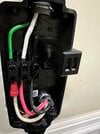I know this has been discussed. I have searched all this forum and others and looked at the information from Tesla but I am still confused.
I want to install two Tesla Universal Wall Chargers in my garage. I will have a sub panel and can only safely install one 60 AMP breaker.
I thought the point of power sharing was that I could have two Wall Chargers share that one 60 AMP breaker. But from what I am reading I have to install 2 60 AMP breakers and when set up the wall chargers will coordinate and never draw more than 48 amps.
But there are still two 60 amp breakers which is over my capacity. What makes this safe and legal other than relying on software and wifi? Or is there something I am completely missing?
Thanks for any help.
I want to install two Tesla Universal Wall Chargers in my garage. I will have a sub panel and can only safely install one 60 AMP breaker.
I thought the point of power sharing was that I could have two Wall Chargers share that one 60 AMP breaker. But from what I am reading I have to install 2 60 AMP breakers and when set up the wall chargers will coordinate and never draw more than 48 amps.
But there are still two 60 amp breakers which is over my capacity. What makes this safe and legal other than relying on software and wifi? Or is there something I am completely missing?
Thanks for any help.



